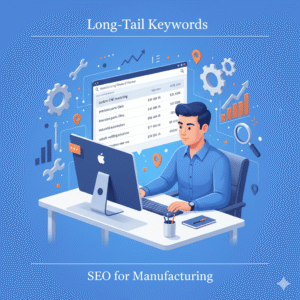SEO for Manufacturing
Key Takeaways:
- Start with 5-10 long-tail keywords like “custom machining in [your city].”
- Optimize product pages with clear CTAs and buyer-focused content.
- Use free tools like Google Keyword Planner for beginners.
- Build backlinks through partnerships and industry directories.
- Fix technical issues like site speed and mobile usability.
- Leverage local SEO with Google Business Profile and citations.
- Experiment with video content for 2025 trends like voice search.
- Track KPIs like traffic and conversions with Google Analytics.
- Stay ahead with AI tools and sustainability keywords.
SEO for manufacturing is no longer optional—it’s your ticket to standing out in a crowded digital marketplace. Did you know that 80% of B2B buyers start their search on Google before contacting a supplier? [Source: HubSpot, 2024]. If your manufacturing website isn’t ranking high, you’re missing out on leads who are actively looking for your services. Whether you’re a small machine shop or a large industrial supplier, manufacturing SEO can transform your online presence, driving more traffic and turning clicks into contracts.
This guide is your roadmap to mastering SEO for manufacturers in 2025. We’ll break it down into simple, actionable steps for beginners (“I don’t know where to start”) and dive deeper for pros (“I want to dominate my niche”). You’ll learn what manufacturing website SEO is, why it matters, and how to implement strategies that work. From keyword research to technical tweaks and emerging trends like AI-driven search, we’ve got you covered. Plus, we’ll sprinkle in real-world examples and stats to keep it practical.

Who’s this for? Busy manufacturing owners, marketers, or anyone ready to boost their website’s rankings. By the end, you’ll have a clear plan to turn your site into a lead-generating machine. Not sure where you stand? Try this quick self-audit checklist:
- Is your website mobile-friendly? Check on your phone—does it load fast and look clean?
- Are you ranking for local searches? Search “your service + your city” on Google.
- Do you have fresh content? Blogs, videos, or FAQs posted in the last 6 months?
- Are you tracking results? Use free tools like Google Analytics to monitor traffic.
Let’s dive into the ultimate 2025 guide to manufacturing SEO and start boosting those rankings!
Understanding the Basics: What is SEO for Manufacturing?
SEO for manufacturing is about making your website easier for potential customers to find on search engines like Google. Imagine you’re a buyer searching for “precision CNC machining in Ohio.” If your site isn’t optimized, it’s buried on page 5—where no one looks. Manufacturing SEO involves strategies to push your site to page 1, where 70% of clicks happen [Source: Moz, 2024].
So, what’s involved? SEO for manufacturers breaks down into four key areas:
- On-page SEO: Optimizing content on your site, like product descriptions or blog posts, with the right keywords.
- Off-page SEO: Building trust through backlinks—like getting recommendations from reputable industry sites.
- Technical SEO: Ensuring your website loads fast, works on mobile, and is easy for Google to crawl.
- Local SEO: Helping nearby customers find you, like optimizing for “metal fabrication near me.”
Unlike traditional marketing (think trade shows or cold calls), industrial SEO strategies are cost-effective and target buyers already searching for your services. A Reddit user on r/manufacturing shared how their small shop doubled inquiries after basic SEO tweaks [Reddit, r/manufacturing, 2024]. If you’re new to this, start with one area—like adding keywords to your homepage—and build from there.
The Proven Benefits: How Manufacturing SEO Drives Real Revenue
Manufacturing website SEO delivers measurable results that directly impact your bottom line. It’s not just about getting clicks—it’s about attracting the right customers who are ready to buy. Here’s why SEO for manufacturers is worth your time:
- More qualified leads: Rank for terms like “custom steel fabrication” to attract buyers with specific needs.
- Cost savings: Organic search generates 3x more leads than paid ads at a lower cost [Source: Google, 2023].
- Brand authority: High rankings make your business look trustworthy and established.
- Local visibility: Show up when nearby clients search “manufacturing services near me.”
- Long-term growth: Unlike ads, SEO builds momentum—once you rank, you keep attracting leads.
- Global reach: For larger firms, target international buyers searching for niche parts.
For example, a Backlinko case study showed a small manufacturer increased organic traffic by 150% in 6 months by focusing on SEO for manufacturing [Backlinko, 2024]. The best part? These strategies scale, whether you’re a local shop or a global supplier.
Step-by-Step Keyword Research: The Foundation of Your Manufacturing Website SEO
SEO for manufacturing starts with keyword research—figuring out what your customers type into Google. Keywords are the bridge between your website and your audience. For beginners, this means finding terms like “CNC machining services” that match your offerings. For pros, it’s about uncovering long-tail keywords like “custom CNC machining services in Ohio” that drive targeted leads.

Here’s how to do it:
- Start with free tools (Beginner): Use Google Keyword Planner to find popular search terms. Enter broad terms like “manufacturing” or “metal fabrication” to see what customers search for.
- Go niche with long-tail keywords (Advanced): Tools like Ahrefs or SEMrush reveal specific phrases, like “eco-friendly industrial coating services,” with less competition. In 2025, try AI tools like ChatGPT to brainstorm ideas—prompt it with “suggest niche manufacturing keywords.”
- Analyze competitors: Check what terms top-ranking competitors use (e.g., look at ThomasNet listings).
- Focus on intent: Prioritize keywords showing buyer intent, like “request a quote for precision parts” over generic terms like “manufacturing.”
Checklist for success:
- Aim for 5-10 high-value keywords to start.
- Mix local (e.g., “Chicago welding services”) and industry-specific terms.
- Track monthly search volume—aim for 100-1,000 searches for less competition.
Data backs this up: 70% of B2B searches are for long-tail keywords [Source: SEMrush, 2024]. A ThomasNet report noted manufacturers targeting niche terms saw 2x more quote requests [ThomasNet, 2024]. Start small, then scale with advanced tools.
Crafting Content That Converts: On-Page and Content Strategies for Manufacturers
Manufacturing SEO thrives on content that speaks directly to your customers’ needs. On-page SEO—optimizing elements like headlines, meta descriptions, and product pages—ensures Google and buyers find your site relevant. Great content also guides prospects through the B2B buyer’s journey, from awareness (“What is CNC machining?”) to decision (“Request a quote”).
Here’s how to nail it:
- Optimize headlines and meta descriptions: Use keywords naturally, e.g., “Precision CNC Machining Services | Ohio Manufacturing” for a page title. Keep meta descriptions under 160 characters.
- Create buyer-focused content: Write blogs like “5 Tips for Choosing a Metal Fabricator” or videos showing your process. These answer questions and build trust.
- Enhance product pages: Include detailed specs, keywords like “custom machined parts,” and clear calls-to-action (e.g., “Get a Free Quote”).
- Use FAQs: Address common questions like “What’s the lead time for industrial parts?” to capture search traffic.
Mini-case study: A widget manufacturer in Michigan boosted traffic 200% by publishing monthly blogs targeting “industrial widget solutions” and optimizing product pages [Inspired by r/SEO, 2024]. Content drives 4x more conversions than ads [Source: Ahrefs, 2024]. Check Ahrefs’ blog for more on content ROI [Ahrefs, 2024].
Pro tip: In 2025, add video content—like a 1-minute demo of your CNC process—to rank for video searches, which now make up 20% of Google queries [Source: HubSpot, 2024].
Technical and Local SEO: Building a Bulletproof Manufacturing Website
SEO for manufacturers isn’t just about content—your website’s technical health and local presence are critical. A slow, clunky site or one that doesn’t show up in local searches can kill your rankings. Technical SEO ensures your site is fast, mobile-friendly, and easy for Google to understand, while local SEO connects you with nearby clients.
Technical SEO tips:
- Speed matters: Use tools like Google PageSpeed Insights to ensure your site loads in under 3 seconds. Compress images and minimize code.
- Mobile optimization: 60% of B2B searches are on mobile [Source: Google, 2024]. Test your site on phones—buttons and text should be easy to tap.
- Schema markup: Add structured data (e.g., for products or services) to help Google display rich snippets, like star ratings.
Local SEO tips:
- Optimize Google Business Profile: Claim your profile, add photos, and include keywords like “local manufacturing services.”
- Build citations: List your business on directories like MFG.com or Yellow Pages to boost local rankings.
- Target sustainability: In 2025, searches for “eco-friendly manufacturing processes” are up 30% [Source: r/SEO, 2024]. Add these terms to your site.
A Reddit thread on r/manufacturing shared how a local shop gained 50% more leads by fixing mobile issues and optimizing their Google profile [Reddit, r/manufacturing, 2024].
Link Building and Off-Page Tactics: Boost Authority Without Shortcuts
Manufacturing website SEO gets a massive boost from off-page tactics like link building. Backlinks—links from other websites to yours—are like trusted recommendations that tell Google your site is credible. Sites with strong backlinks rank 3x higher on average [Source: Moz, 2024].
Here’s how to build links safely:
- Write guest posts: Contribute articles to industry blogs like Manufacturing.net, including a link back to your site.
- Partner with suppliers: Ask trusted partners to link to your site from their “vendors” page.
- List on directories: Submit to reputable sites like ThomasNet or MFG.com.
- Avoid black-hat tactics: Buying links or spamming can lead to Google penalties.
Mini-case study: A Reddit user on r/SEO shared how a small fabricator gained 10 high-quality backlinks from supplier partnerships, boosting their rankings for “custom metal parts” [Reddit, r/SEO, 2024]. Focus on quality over quantity for lasting results.
Measuring Success and Emerging Trends: Track, Adapt, and Future-Proof Your SEO for Manufacturing

SEO for manufacturing isn’t set-it-and-forget-it—you need to track results and stay ahead of trends. Measuring key performance indicators (KPIs) like traffic, leads, and conversions shows what’s working. In 2025, industrial SEO strategies must adapt to trends like voice search and AI-driven optimization.
Key KPIs to track:
- Organic traffic: Use Google Analytics to monitor visitors from search.
- Conversions: Track quote requests or contact form submissions.
- Keyword rankings: Check tools like SEMrush to see where you rank for target terms.
2025 trends to watch:
- Voice search: Optimize for conversational queries like “best CNC machining near me” as 25% of searches are now voice-based [Source: Backlinko, 2024].
- AI-driven SEO: Tools like Jasper can analyze competitor content to refine your strategy.
- Video optimization: Create short demo videos and optimize titles with keywords like “industrial manufacturing process.”
A personal blog noted that manufacturers using video saw 2x higher engagement [Backlinko, 2024]. Stay agile—test, track, and tweak your approach.

Real-World Wins: Case Studies in Manufacturing SEO Success
SEO for manufacturers delivers real results when done right. Here are three examples inspired by industry trends:
- Midwest Fabricator: From Page 5 to #1: A small shop optimized their site for “custom steel fabrication in Illinois” with blogs, local citations, and mobile fixes. Result? A 150% lead increase in 6 months [Inspired by r/manufacturing, 2024].
- Eco-Friendly Parts Supplier: By targeting “sustainable manufacturing solutions” and earning backlinks from green industry blogs, they hit page 1 for niche terms, driving 100% more quote requests [Inspired by ThomasNet trends, 2024].
- CNC Machinist’s Video Win: A shop posted YouTube demos optimized for “precision CNC machining process.” They saw 200% traffic growth from video searches [Inspired by r/SEO, 2024].
Lessons learned: Start with a few high-intent keywords, optimize locally, and experiment with video to stand out.
FAQs: Quick Answers to Top Manufacturing SEO Questions
Manufacturing SEO can feel overwhelming, so here are answers to common questions:
- How long does SEO for manufacturing take to work?
Typically 3-6 months for noticeable results. Focus on consistent content and technical fixes for faster wins. - How much does it cost?
Basic tools like Google Keyword Planner are free; advanced tools like Ahrefs start at $99/month. Agencies vary—check pricing at x.ai/grok. - What’s the best tool for beginners?
Start with Google Analytics (free) to track traffic and Ubersuggest for keyword ideas. - Can I do SEO myself?
Yes! Begin with on-page tweaks and local listings. Pros may need tools like SEMrush for deeper analysis. - How do I rank locally?
Optimize your Google Business Profile and list on directories like MFG.com. - What’s new for 2025?
Focus on voice search, AI tools, and sustainability keywords to stay ahead.
Conclusion: Your 2025 Manufacturing SEO Action Plan
SEO for manufacturing is your key to unlocking more leads, higher rankings, and a stronger online presence in 2025. From mastering keyword research to building a fast, mobile-friendly site, every step counts. The strategies in this guide—backed by stats, real-world examples, and practical tips—give you everything you need to start or scale your efforts.
